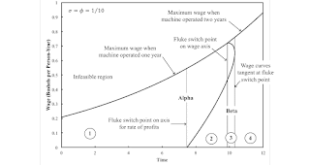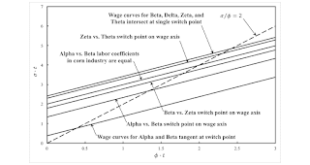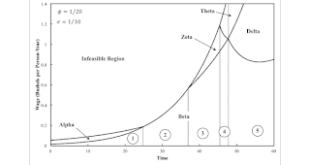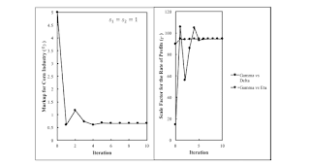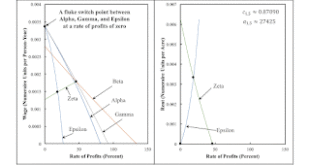1.0 Introduction This post is an attempt to work through some linear algebra that some have used to understand Karl Marx's Capital. I have recently explained how, in a simple model, prices of production are equal to labor values if the organic composition of capital does not vary among industries. That special case is the setting of volume 1. In capitalism, workers rent themselves out to their employers. They work longer, under the dominion of capital, than needed to produce the...
Read More »Two Special Cases For The Labor Theory Of Value
1.0 Introduction A simple labor theory of value holds in two special cases. The rate of profits in the system of prices of production is zero. The vector of direct labor coefficients is an eigenvector of the Leontief input-output matrix corresponding to the maximum eigenvalue. I do not know if I've worked through this alone before. A more rigorous approach would prove the uniqueness of the solution. 2.0 The Setting Suppose a capitalist economy is observed at a given point in time. n...
Read More »Variation On An Example From Schefold
Figure 1: Variation in the Economic Life of a Machine with Technical Progress This post varies the coefficients of production in an example from Bertram Schefold. I wanted to have 'nice' fractions at a time of zero. Qualitatively, this looks like a previous post. Reviewers for a recent rejection of an article with another fixed capital example objected to this type of model. I need to relate technical progress to a well-known type (Harrod-neutral, Marx-biased, or whatever) or produce some...
Read More »A Parameter Space for an Example of Harrod-Neutral Technical Progress
Figure 1: A Two-Dimensional Parameter Space The above is for this example. I wish somebody would be inspired by this to write it up with mathematical proofs. What I see here is found by numerical methods. Figure 1 shows a partition of the parameter space based on fluke switch points. The dashed line shows the temporal path in the previous post. Each of the solid lines are parallel affine functions, with a slope of unity. A proof that these slopes are unity should be able to handle a model...
Read More »Another Example of Harrod-Neutral Technical Progress And The Choice Of Technique
Figure 1: Variation in the Maximum Wage and the Cost-Minimizing Technique with Time This post presents an example in which some coefficients of production vary from those in example. Reswitching, capital reversing, and the reverse substitution of labor do not arise in this example. Table 1 shows the coefficients of production for this example. The labor coefficients vary identically with the the labor coefficients in the previous example. a2,1(a), a3,1(a), a2,1(b), a3,1(b), a1,2(c),...
Read More »Harrod-Neutral Technical Change And The Choice Of Technique
Figure 1: Variation in the Maximum Wage and the Cost-Minimizing Technique with Time1.0 Introduction I thought I would revisit the application of my analysis of fluke switch points to an example of Harrod-neutral technical change. Two techniques are assumed to experience Harrod-neutral technical change. The same commodities are produced with both techniques. No capital goods are produced for one technique that are unproduced in the other. Consequently, the techniques have no processes in...
Read More »How To Find Fluke Switch Points
Figure 1: Convergence of Newton Method This post steps through an algorithm for finding a fluke switch point. I used a different example when I tried to explain this before. Today, I use an example building on my draft ROPE Article. Consider Figure 3 in this post, repeated below as Figure 2. Let s1 = s2 = 1. I want to find s3, the markup in the corn industry, such that the wage curves for Gamma, Delta, Eta, and Theta intersect at a single switch point. One wants to find a function one of...
Read More »Ludwig Von Mises Wrong On Capital Theory
We compare the conditions of two isolated market systems A and B. Both are equal in size and population figures, the state of technological knowledge, and in natural resources. They differ from one another only in the supply of capital goods, this supply being larger in A than in B. This enjoins that in A many processes of production are employed with which the output is greater per unit of input than with those employed in B. In B one cannot consider the adoption of these processes on...
Read More »Intensive Rent, Extensive Rent, And Absolute Rent
1.0 Introduction I have decided that this previous post is inadequate. If intensive rent exists on some type of land, the system of equations for prices of production cannot include a process that only partially cultivates some other type of land producing the agricultural commodity. So to form an example with both intensive and extensive rent, I need the technology to specify the possibility of cultivating at least three types of land. I might as well include markup pricing so as to...
Read More »A Fluke Case And The Disappearance Of Intensive Rent
Figure 1: Wage Curves For A Fluke Case1.0 Introduction This post examines perturbations around a fluke case in a model of intensive rent. The model illustrates an analysis of prices and the choice of technique in which the quantity of commodites produced matters. Yet the level and composition of net output are taken as given, independent of any variation, for example, from their dependence on distribution and relative prices. The model also illustrates a case in which prices of production...
Read More » Heterodox
Heterodox

